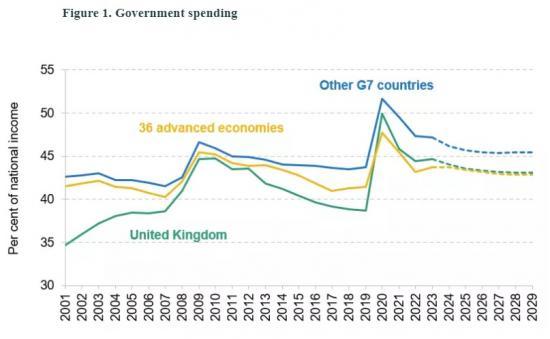Spending As Much As Other Countries But Taxing Less Is Unlikely To Be Sustainable
22nd April 2024

How do the UK's levels of tax and spend compare with other advanced economies?.
The International Monetary Fund (IMF) has released its new medium-term forecast for the world economy and the outlook for the public finances of individual countries. We compare the situation in the UK with 36 other comparator countries and look at how things have changed since the turn of the century and what the outlook looks like going forward.
How have government spending and revenues evolved in the UK, compared with other countries?
As shown in Figure 1 and Figure 2 respectively, the UK's total government spending and revenues are now closer to the average of the rest of the G7 as well as to the average of a broader set of 36 comparator countries than they were in 2001. Going forward, the UK is forecast to close the gap with the G7 average even further. This would leave government spending and revenues at historically high levels for the UK, but still a bit below the G7 average. And while we already spend the same as the average of a broader set of international peers, we will not tax the same even by 2029.
Size of the state
Government spending in the UK was 8% of national income below the G7 average in 2001.
It then increased comparatively faster in the 2000s under New Labour governments, reducing the gap to 3% in 2007 on the eve of the financial crisis. The financial crisis was associated with a particularly big increase in public spending in the UK, further reducing the gap to only 1.2% of national income in 2010.
The subsequent period of austerity rolled back the size of the state - and from 2012 did so more than in other countries, widening the gap with the G7 average to 5% of national income in 2019. But again, a global crisis - this time COVID-19 - was associated with a particularly big increase in spending in the UK.
Despite cutting the levels of spending slightly from their pandemic peak, government spending is expected to settle at a much higher level than before the pandemic. This increase is forecast to be the fourth-highest increase out of the 37 comparator countries over the period 2019-29.
The size of the state is expected to settle at the average of the 36 other comparator countries over the medium term and around 2.4% of national income (or £66 billion in today's terms) below the G7 average in 2029. If this materialises, the gap between the UK and the G7 average in terms of spending as a share of national income will have fallen by 5.6% of national income between 2001 and 2029. Had the size of the UK state remained as far below the G7 average as it was at the turn of the century, we would be spending around £155 billion a year less.
Read the full article at the IFS
